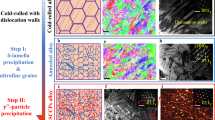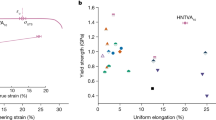Abstract
In spite of the recent spectacular achievements in developing high-temperature (transition temperature Tc ≥ 77 K) superconductivity in systems generically represented by ABa2Cu3O7–x (where A = Y, La, Nd, Sm, Eu, Gd, Ho, Er, Lu)1,2, it has been difficult to prepare large powder sample batches (≥0.5 kg). More importantly, efforts to consolidate or sinter superconducting powder samples or to place powders (such as Y–Ba–Cu–O) in useful environments or monolithic structures which are not brittle and friable, and the fabrication of high-temperature superconducting products have been frustrating at best3. Based on the process integration of several fundamental principles involving shock-compression science4,5, we have successfully fabricated composite/laminate monoliths containing shock-compacted, consolidated and bonded Y–Ba–Cu–O superconducting powder channels (with Tc≥90K) in a solid copper matrix6. Using ammonium-nitrate-based explosives (with detonation velocities, VD, adjusted to be ∼1,800 m s–1), we have progressed from shock-consolidated, superconducting YBa2Cu3O7 powder-channel rings with mean diameters of 4.4cm and 4mm2 cross-sections in explosively (implosive shock-wave) clad solid copper matrices, to monoliths from which copper matrix rings have been cut containing shock-consolidated, superconducting YBa2Cu3O7 powder channels with mean diameters of 24 cm (with 2.5 cm width) and cross-sections of 1.85cm2.
This is a preview of subscription content, access via your institution
Access options
Subscribe to this journal
Receive 51 print issues and online access
$199.00 per year
only $3.90 per issue
Buy this article
- Purchase on Springer Link
- Instant access to full article PDF
Prices may be subject to local taxes which are calculated during checkout
Similar content being viewed by others
References
Chu, C. W. et al. Phys. Rev. Lett. 58, 405–407 (1987).
Wu, M. K. et al. Phys. Rev. Lett. 58, 908–911 (1987).
Fletcher, F. J. Metals May (1987).
Meyers, M. A. & Murr, L. E. (eds) Shock Wave and High-Strain-Rate Phenomena in Metals, (Plenum, New York, 1981).
Murr, L. E., Meyers, L. E. & Staudhammer, K. P. (eds) Metallurgical Applications of Shock-Wave and High-Strain-Rate Phenomena (Dekker, New York, 1986).
Murr, L. E., & Hare, A. W. US and International Patent Application (29 July, 1987).
Murr, L. E., Shankar, S., Hare, A. W. & Staudhammer, K. P. Scripta metall. 17, 1353–1359 (1983).
Murr, L. E. in Shock Waves and High-Strain-Rate Phenomena in Metals (eds Meyers, M. A. & Murr, L. E.) 607–673 (Plenum, New York, 1981).
Murr, L. E. & Hiskey, J. B. Metall. Trans. 12B, 255–267 (1981).
Livingstone, J. D. & Schadler, H. W. Progress in Materials Science Vol. 12 (ed. Chalmers, B.) 185–287 (1964).
Geballe, T. H. in Critical Materials Problems in Energy Production (ed. Stein, C.) (Academic, New York, 1976).
Hor, P. H. et al. Phys. Rev. Lett. 58, 911–912 (1987).
Chu, C. W., Hor, P. H., Meng, R. L., Gao, L. & Huang, Z. J. Science 235, 567–568 (1987).
Author information
Authors and Affiliations
Rights and permissions
About this article
Cite this article
Murr, L., Hare, A. & Eror, N. Shock-compression fabrication of high-temperature superconductor/ metal composite monoliths. Nature 329, 37–39 (1987). https://doi.org/10.1038/329037a0
Received:
Accepted:
Issue Date:
DOI: https://doi.org/10.1038/329037a0
This article is cited by
-
Properties of massive Ag/YBCO contacts obtained by explosive compaction with subsequent heat treatment
Combustion, Explosion, and Shock Waves (1995)
-
Explosive treatment of SHS end products (of high-temperature superconductors)
Journal of Engineering Physics and Thermophysics (1992)
-
Effect of shock waves and subsequent quenching in stream of coolant on YBa2Cu3Ox
Combustion, Explosion, and Shock Waves (1991)
-
Investigation of the structure and properties of shock-consolidated Y?Ba?Cu?O high-TC ceramics
Combustion, Explosion, and Shock Waves (1991)
-
Thermal recovery in shock-wave modified copper-oxide superconductors
Journal of Materials Science Letters (1990)
Comments
By submitting a comment you agree to abide by our Terms and Community Guidelines. If you find something abusive or that does not comply with our terms or guidelines please flag it as inappropriate.



